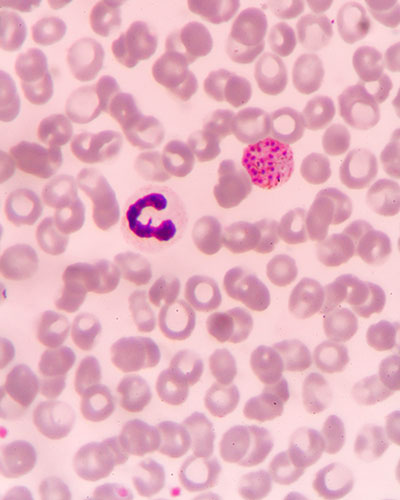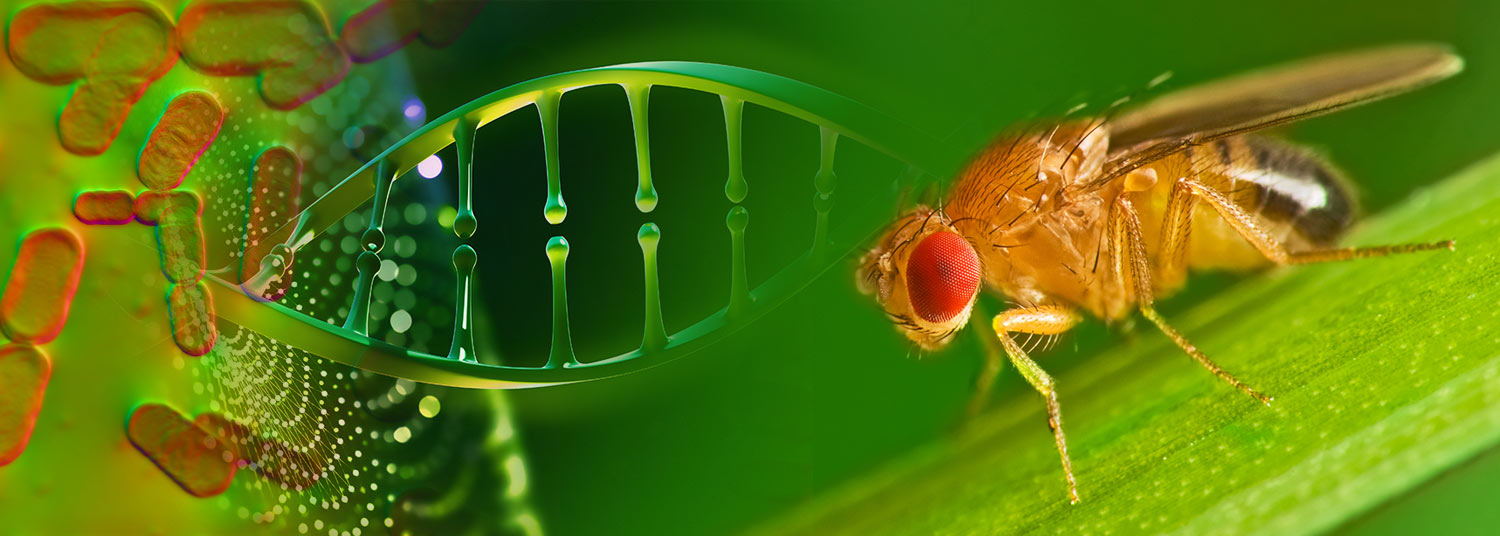July 28, 2022 | Heide Aungst
This finding contributes to understanding that evolution is not strictly driven from parent to offspring
 A fruit fly genome is not a just made up of fruit fly DNA – at least for one fruit fly species. New research from the University of Maryland School of Medicine’s (UMSOM) Institute for Genome Sciences (IGS) shows that one fruit fly species contains whole genomes of a kind of bacteria, making this finding the largest bacteria-to-animal transfer of genetic material ever discovered. The new research also sheds light on how this happens.
A fruit fly genome is not a just made up of fruit fly DNA – at least for one fruit fly species. New research from the University of Maryland School of Medicine’s (UMSOM) Institute for Genome Sciences (IGS) shows that one fruit fly species contains whole genomes of a kind of bacteria, making this finding the largest bacteria-to-animal transfer of genetic material ever discovered. The new research also sheds light on how this happens.
The IGS researchers, led by Julie Dunning Hotopp, PhD, Professor of Microbiology and Immunology at UMSOM and IGS, used new genetic long-read sequencing technology to show how genes from the bacteria Wolbachia incorporated themselves into the fly genome up to 8,000 years ago.
The researchers say their findings show that unlike Darwin’s finches or Mendel’s peas, genetic variation isn’t always small, incremental, and predictable.
Scientist Barbara McClintock first identified “jumping genes” in the 1940s like those that can move around within or transfer into other species genomes. However, researchers continue to discover their significance in evolution and health.
“We did not have the technology previously to unequivocally demonstrate these genomes-inside-genomes showing such extensive lateral gene transfer from the bacteria to the fly,” explained Dr. Dunning Hotopp. “We used state-of-the-art long-read genetic sequencing to make this important discovery.”
The new research has been published in the June issue of Current Biology.
In the past, researchers had to break DNA into short pieces in order to sequence it. Then they needed to assemble them, like a jigsaw puzzle, to look at a gene or section of DNA. Long-read sequencing, however, allows for sequences more than 100,000 DNA letters, turning a million-piece jigsaw puzzle into one made for toddlers.
In addition to the long reads, the researchers validated junctions between integrated bacteria genes and the host fruit fly genome. To determine if the bacteria genes were functional and not just DNA fossils, the researchers sequenced the RNA from fruit flies specifically looking for copies of RNA that were created from templates of the inserted bacterial DNA. They showed the bacteria genes were encoded into RNA and were edited and rearranged into newly modified sequences indicating that the genetic material is functional.
An analysis of these unique sequences revealed that the bacteria DNA integrated into the fruit fly genome in the last 8,000 years –exclusively within chromosome 4—expanding the chromosome size by making up about 20 percent chromosome 4. Whole bacterial genome integration supports a DNA-based rather than an RNA-based mechanism of integration.
 Dr. Dunning Hotopp and colleagues found a full bacterial genome of the common bacteria Wolbachia transferred into the genome of the fruit fly Drosophila ananassae. They also found nearly a complete second genome and much more with almost 10 copies of some bacterial genome regions.
Dr. Dunning Hotopp and colleagues found a full bacterial genome of the common bacteria Wolbachia transferred into the genome of the fruit fly Drosophila ananassae. They also found nearly a complete second genome and much more with almost 10 copies of some bacterial genome regions.
“There always have been some skeptics about lateral gene transfer, but our research clearly demonstrates for the first time the mechanism of integration of Wolbachia DNA into this fruit fly’s genome,” Dr. Dunning Hotopp said.
“This new research shows basic science at its best,” said Dean E. Albert Reece, MD, PhD, MBA, who is also Executive Vice President for Medical Affairs, UM Baltimore, the John Z. and Akiko K. Bowers Distinguished Professor, and Dean, University of Maryland School of Medicine. “It will make a contribution to our understanding of evolution and may even prove to help us understand how microbes contribute to human health.”
Wolbachia is an intracellular bacteria that infects numerous types of insects. Wolbachia transmits its genes maternally through female egg cells. Some research has showed that these infections are more mutualistic than parasitic, giving insects advantages, such as resistance to certain viruses.
Sequenced just three years before the human genome, fruit flies have long been used in genomic research because of the abundance of common fly-human genetic similarities. In fact, 75 percent of genes causing human disease can also be found in the fruit fly.
Authors from the Institute of Genome Sciences, University of Maryland School of Medicine, at the time of writing, include Eric S. Tvedte; Mark Gasser; Xuechu Zhao, Lab Research Specialist; Luke J. Tallon, Executive Scientific Director, Maryland Genomics; Lisa Sadzewicz, Executive Director, Maryland Genomics Administration; Robin E. Bromley, Lab Research Supervisor; Matthew Chung; John Mattick, PostDoc, and Benjamin C. Sparklin.
Eric S. Tvedte is currently affiliated with NCBI at the National Institutes of Health, Bethesda, MD; Mark Gasser is currently affiliated with Applied Physics Laboratory, Johns Hopkins University, Laurel, MD; Matthew Chung is currently affiliated with the National Institute for Allergy and Infectious Disease at the National Institutes of Health, Bethesda, MD; and Benjamin C. Sparkin is currently affiliated with AstraZeneca, Rockville, MD.
This work was supported by National Institute of Allergy and Infectious Diseases grant U19AI110820 and National Institutes of Health grant R01CA206188.
About the University of Maryland School of Medicine
Now in its third century, the University of Maryland School of Medicine was chartered in 1807 as the first public medical school in the United States. It continues today as one of the fastest growing, top-tier biomedical research enterprises in the world -- with 46 academic departments, centers, institutes, and programs, and a faculty of more than 3,000 physicians, scientists, and allied health professionals, including members of the National Academy of Medicine and the National Academy of Sciences, and a distinguished two-time winner of the Albert E. Lasker Award in Medical Research. With an operating budget of more than $1.3 billion, the School of Medicine works closely in partnership with the University of Maryland Medical Center and Medical System to provide research-intensive, academic and clinically based care for nearly 2 million patients each year. The School of Medicine has nearly $600 million in extramural funding, with most of its academic departments highly ranked among all medical schools in the nation in research funding. As one of the seven professional schools that make up the University of Maryland, Baltimore campus, the School of Medicine has a total population of nearly 9,000 faculty and staff, including 2,500 students, trainees, residents, and fellows. The combined School of Medicine and Medical System (“University of Maryland Medicine”) has an annual budget of over $6 billion and an economic impact of nearly $20 billion on the state and local community. The School of Medicine, which ranks as the 8th highest among public medical schools in research productivity (according to the Association of American Medical Colleges profile) is an innovator in translational medicine, with 606 active patents and 52 start-up companies. In the latest U.S. News & World Report ranking of the Best Medical Schools, published in 2021, the UM School of Medicine is ranked #9 among the 92 public medical schools in the U.S., and in the top 15 percent (#27) of all 192 public and private U.S. medical schools. The School of Medicine works locally, nationally, and globally, with research and treatment facilities in 36 countries around the world. Visit medschool.umaryland.edu
About the Institute for Genome Sciences
The Institute for Genome Sciences (IGS) at the University of Maryland School of Medicine has revolutionized genomic discoveries in medicine, agriculture, environmental science, and biodefense since its founding in 2007. IGS investigators research areas of genomics and the microbiome to better understand health and disease, including treatments, cures, and prevention. IGS investigators also lead the development of the new field of microbial forensics. IGS is a leading center for major biological initiatives currently underway including the NIH-funded Human Microbiome Project (HMP) and the NIAID-sponsored Genomic Sequencing Center for Infectious Diseases (GSCID). Follow us on Twitter @GenomeScience.
Contact
Heide Aungst
HAungst@som.umaryland.edu
216-970-5773 (cell)
Related stories

Wednesday, August 28, 2024
Leading Computational Scientist and Oncology Researcher Elana Fertig, PhD, Appointed as New Director of the Institute for Genome Sciences at the University of Maryland School of Medicine
University of Maryland School of Medicine (UMSOM) Dean Mark T. Gladwin, MD, announced today the appointment of Elana J. Fertig, PhD, FAIMBE, as the new Director of the School’s Institute for Genome Sciences (IGS). She is an internationally-recognized researcher known for her work in integrating spatial multi-omics technologies with mathematical models to develop a new predictive medicine paradigm in cancer. Spatial technologies allow researchers to learn about any cell type inside of natural tissue, including gene activity and cell interactions.

Tuesday, December 03, 2019
UM School of Medicine Researchers Institute for Genome Sciences' Researchers Discover Potential New Treatment for Tropical Parasitic Disease Using Genomics
Using innovative RNA sequencing techniques, researchers at the University of Maryland School of Medicine (UMSOM) Institute for Genome Sciences identified a promising novel treatment for lymphatic filariasis, a disabling parasitic disease that is difficult to treat. The potential new therapy is an experimental cancer drug called JQ1 and targets proteins found prominently in the worm’s genome; it appears to effectively kill the adult worms in a laboratory setting, according to the study which was published today in the journal mSystems.

Tuesday, August 13, 2019
Researchers Identify How Vaginal Microbiome Can Elicit Resistance or Susceptibility to Chlamydia
The vaginal microbiome is believed to protect women against Chlamydia trachomatis, the etiological agent of the most prevalent sexually transmitted infections (STIs) in developed countries. New research by the University of Maryland School of Medicine (UMSOM) shows how the microbiome can either protect or make a woman more susceptible to these serious infections.

Thursday, April 04, 2019
UM School of Medicine's Institute for Genome Sciences Awarded $17.5 Million Grant for Infectious Disease Research
The Institute for Genome Sciences (IGS) at the University of Maryland School of Medicine (UMSOM) was awarded $17.5 million from the National Institute of Allergy and Infectious Diseases (NIAID) to fund the IGS Genome Center for Infectious Diseases (GCID) for another five years.

Wednesday, March 27, 2019
New Study Finds That Bacteria and Immunity in the Cervix May be Key to Predicting Premature Birth
Spontaneous preterm birth (sPTB), defined as birth before 37 weeks of gestation, and the related complications, are the largest contributors to infant death in the United States and worldwide, according to the World Health Organization. Researchers at the University of Maryland School of Medicine (UMSOM) have discovered that bacteria and innate immune factors in a woman’s birth canal and cervix may increase the risk of spontaneous preterm birth or provide protection against such births.

Tuesday, February 12, 2019
UMSOM Scientists Call for Unrestricted Usage of Public Genome Data
Researchers at the Institute for Genome Sciences (IGS) at the University of Maryland School of Medicine (UMSOM) called for open access to genome data, stating that unrestricted usage is needed for progress in combating the world’s most serious diseases.

Friday, February 08, 2019
University of Maryland School of Medicine Genome Scientists Develop Novel Approaches to Studying the Most Widespread Form of Malaria
Scientists at the Institute of Genome Sciences (IGS) at the University of Maryland School of Medicine (UMSOM) have developed a novel way with genome sequences to study and better understand transmission, treat and ultimately eradicate Plasmodium vivax, the most widespread form of malaria.

Thursday, September 27, 2018
University of Maryland School of Medicine Scientist Receives Prestigious Microbiome Award
Owen White, PhD, professor of epidemiology and public health, and Associate Director for Informatics at the Institute for Genome Sciences (IGS) at the University of Maryland School of Medicine (UMSOM), has received the 2018 Microbiome Pioneer Award. The prestigious honor is part of the Bioinformatics for the Microbiome Symposium organized by Stanford University. The microbiome is the name given collectively to the community of trillions of microbial organisms that live on and within our bodies.

Monday, May 14, 2018
New Research: Some Gut Bacteria May Protect Against Intestinal Infection
Scientists at the University of Maryland School of Medicine (UMSOM) have for the first time found evidence that the presence of a key species in the human gut microbiome is associated with protection from infection with typhoid fever. If the research is borne out, it could offer an exciting new way to reduce intestinal infections from microbes.

Wednesday, May 25, 2016
UMSOM Researchers Develop New Way to Decode Large Amounts of Biological Data
A University of Maryland School of Medicine researcher has helped develop an innovative computing technique that, on very large amounts of data, is both faster and more accurate than current methods. To spur research, a program using this technique is being offered for free to the biomedical research community.

